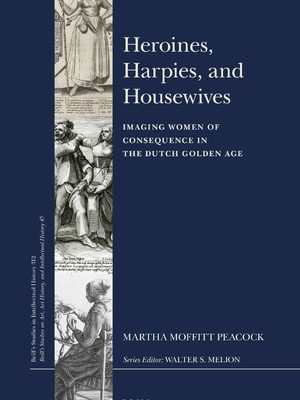Heroines, Harpies, and Housewives: Imaging Women of Consequence in the Dutch Golden Age is a timely study by Martha Moffitt Peacock that reflects revived scholarly interest in female patrons, artists, and the economic and social contributions of women in the seventeenth-century Netherlands. Unlike other recent art historical publications, however, Peacock breaks down patriarchal archetypes and stereotypes by critically examining the social and artistic consequences of these distinctly gendered products of the Dutch Republic.
In line with Peacock’s pithy title, Heroines, Harpies, and Housewives follows a tripartite framework. Although organized chronologically, the “interrelationships” of these female archetypes are also considered (4). Peacock’s subtitle, Imaging Women of Consequence, truly summarizes the objective of her research. “Consequence”, for Peacock, categorically connotes importance as well as effect (2). Further, by employing gender as a vital “historical” category and an “analytical” one, Peacock strives to demonstrate how Dutch women participated in, and renegotiated, artistic and intellectual life (3). Peacock balances this approach by duly acknowledging that gender anxiety and patriarchal control existed, and points to the ever-present tension of gender in early modern art as evidence.
Above all, Peacock is concerned with providing agency to the historical female experience. Central to this objective is the biography and visual legacy of the famous Kenau Simonsdr. Hasselaer (1526-1588) of besieged Haarlem. Specifically, Peacock aims to invoke “discourse initiated by the gender-breaching heroines” like Kenau who emerged as “manly” cultural icons and became part of collective cultural memory during the Spanish Revolt in the Northern Netherlands (2). Kenau’s role as a genesis figure of the strong Dutch woman reverberates throughout Peacock’s book, and the multidisciplinary sources she looks to as evidence of this influence are reflective of the overall breadth and quality of her research.
Following a succinct historiography that begins with twentieth-century feminist art history, philosophical models, and ends with contemporary social learning theory in the introduction, Peacock’s chapter 2 is devoted to the Heroine archetype. In opposition to the masculine tradition of hero tales, Peacock examines a counter tradition, the Catalogs of Good Women, that reveres mythological, biblical, and contemporary women who accomplished masculine deeds but retained their “feminine” virtues. This analysis is the foundation of her thesis that transgressive but unifying women furthered Dutch independence from Spain. Following subsections on individual Revolt heroines and the impact of print media on their popularity, Peacock considers the symbolism of mirror-gazing women, and the Maid of Holland topos, themes that are later revisited in the conclusion. The rest of this chapter concerns cultural heroines: particularly Anna Maria van Schurman (1607-1678) and her network, and female artists such as Clara Peeters (c.1580-1589-c.1621/1641). Peacock admits that this chapter is not comprehensive. The examples she cites are, of course, exceptional and do not reflect the social, educational, and financial barriers faced by many women. In addition, the Heroines chapter covers breadth of subjects which proves a bit confusing to the reader, although the alliterative chapter titles are striking.
Chapter 3 shifts to the negative archetype of Harpies, or shrewish and gender-crossing characters in Dutch culture, such as Dulle Griet. Peacock’s chapter encompasses a variety of early modern proverbs, comedic farces, and didactic images that express cultural discomfort over female heroines, rulers, and more generally, the stereotypical “overbearing” women of Dutch society (190). Although this section is rich in color and black and white illustrations, the reproductions are small, which makes the print inscriptions illegible. Nevertheless, in the text, Peacock examines relevant literary passages in English, with the footnotes of the original Dutch located directly below. Peacock also expands scholarly knowledge of this visual topos by looking to less familiar sources, such as an early woodcut representation of ‘The Upside-Down World’ (1590s; Fig. 3.1) and works now known only in reproduction such as Joachim van den Heuvel (attr.), Battle for the Trousers (Fig. 3.3).
Peacock’s final chapter, Housewives, serves as a pseudo conclusion to her introduction and can easily be read alone. As one of the most persuasive sections, Peacock charts new ways to consider the intersections of public and private domains, with particular attention to female networks of sociability. Peacock argues that cultural acceptance of female independence was especially forged by Dutch Regentesses. By adopting “male” conventions in commissioned portraits, Regentessess emphasized their business acumen, intellect, and civic importance. Notably, Peacock positions the role of housewives as complementary to such female public figures. Rather than dismissing domestic scenes of women as creations of the “male gaze”, Peacock empowers the historical female gaze (and the modern viewer’s gaze). This outcome is apparent in her in-depth consideration of prints by Geertruydt Roghman (1625- c.1651). Her analysis offers a fresh perspective on Roghman’s art and reveals how various desexualized, domestic contributions of women fostered Dutch patriotism and societal gain.
Throughout the book, Peacock successfully argues that women of the Dutch Republic benefitted from a unique cultural position in a specific historical moment. As both foreign travelers and contemporary Dutch authors remarked, seventeenth-century Dutch women appeared more independent than their European counterparts. Peacock cites high literacy rates, access to legal recourse, shifts in marriage patterns, and the changing spaces of life in urban centers as influential. According to the author, these factors converged to form a subversion of patriarchal culture that altered perceptions of women and allowed women to become “active agents” in their respective environments, which is reflected in different manners throughout her chapters (28).
CoverIn her consideration of the consequence of Dutch Revolt heroines in cultural memory, Peacock reveals that combative women became celebrated agents of female legacy by challenging female archetypes. Peacock’s research persuasively elides this sentiment with the reception of female intellectuals and painters, as well as the literary and lived experiences of a wide range of powerful women in the Dutch Republic. Each chapter of this book can be read individually, but all three work well collectively. Peacock’s book clearly draws on her previous publications and years of research, forming an important addition to the field.
Laura E. Thiel-Convery
Toronto
